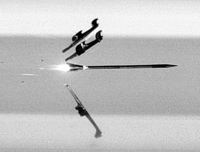
Photo from wikipedia
Na and Na/K alloys in the liquid phase can be absorbed into amorphous silica gel at loadings up to 40 wt%. Further heating of these so-called stage 0 materials at… Click to show full abstract
Na and Na/K alloys in the liquid phase can be absorbed into amorphous silica gel at loadings up to 40 wt%. Further heating of these so-called stage 0 materials at 150 or 400 °C furnishes stage I and stage II materials, respectively, as free-flowing powders that can be handled under much safer conditions than the corresponding starting materials. Stage I Na and Na2K possess valuable reducing properties and they have found a variety of low impact applications in organic synthesis, including, e.g., the reductive deprotection of several functional groups, the development of safer protocols to operate the Bouveault–Blanc and the Birch reductions, and a new and particularly efficient approach to the Grignard and Darzens reactions. 1 Introduction 2 Reductive Deprotection Procedures 3 Bouveault–Blanc Reduction of Esters 4 Ammonia-Free Birch Reductions 5 Synthesis of Alkyldiaryl- and Dialkylarylphosphines 6 C–C Bond Forming Reactions 7 Further Applications 8 Conclusion
Journal Title: Synthesis
Year Published: 2017
Link to full text (if available)
Share on Social Media: Sign Up to like & get
recommendations!